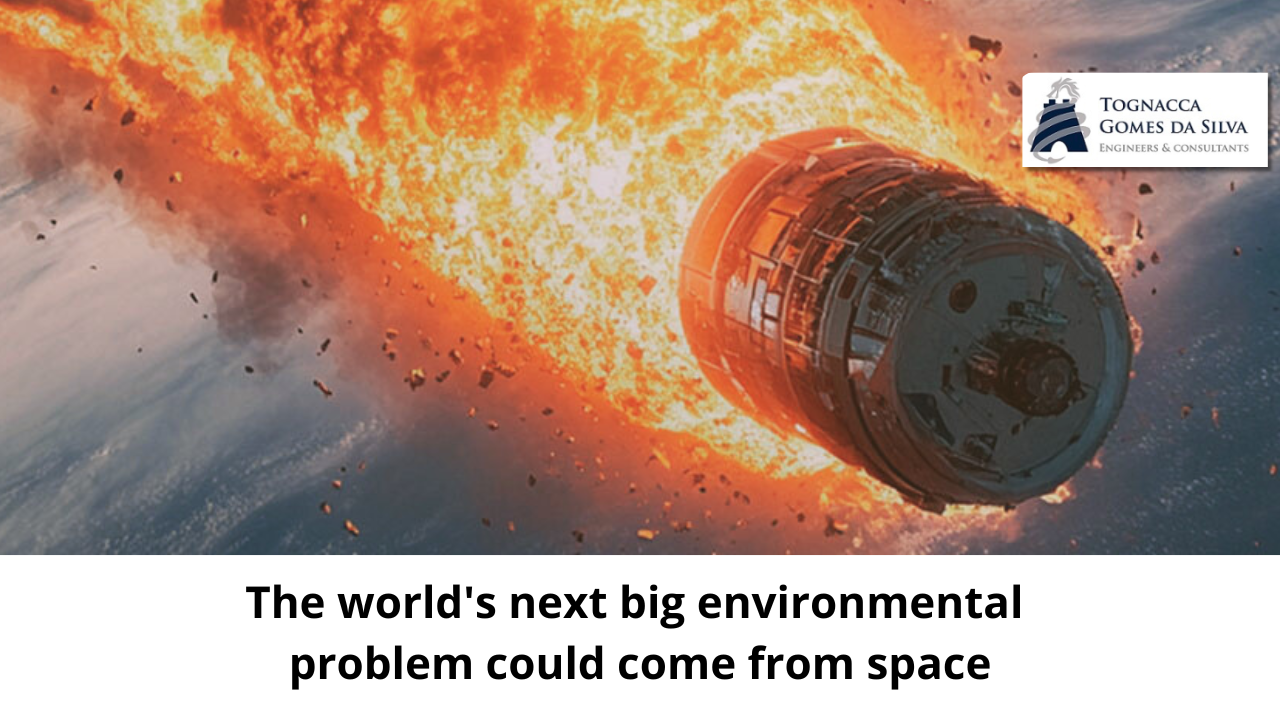Early on a Sunday morning in September, a team of 12 sleep-deprived and jet-lagged researchers gathered at the world’s most remote airport. There, on Easter Island, some 3,750 km off the coast of Chile, they were preparing for a chase of a lifetime: a race to capture the last moments of a satellite as it fell from space and burst into flames until it turned to ash in the sky. .
This spacecraft was Salsa, one of four satellites that were part of the European Space Agency’s (ESA) Cluster constellation. Salsa and his companions had been studying Earth’s magnetic field since the early 2000s, but their mission had come to an end. Months earlier, the spacecraft was sent into a death spiral that would end in a flaming disintegration, about 1,000 miles off the coast of Easter Island, high in Earth’s atmosphere.
Now scientists were ready to record reentry as it happened. Equipped with precise trajectory calculations from ESA ground control, the researchers took off in a rented business jet, with 25 cameras and spectrometers mounted in the windows. The hope was to be able to gather valuable information about the physical and chemical processes that occur when satellites burn up as they fall to Earth at the end of their missions.
This type of study is becoming increasingly urgent. About 15 years ago, fewer than a thousand satellites orbited our planet. Today, that number has risen to around 10,000, and with the rise of satellite constellations like Starlink, that number is expected to increase tenfold by the end of this decade.
Letting these satellites burn up in the atmosphere at the end of their lives helps keep the amount of space debris to a minimum. However, in doing so, satellite ash is deposited in the middle layers of the Earth’s atmosphere. This metallic ash can harm the atmosphere and potentially alter the climate. Scientists still don’t know how serious the problem could be in the coming decades. The ash from re-entries contains substances that harm the ozone layer. Modeling studies have shown that some of its components can also cool Earth’s stratosphere, while others can warm it. Some fear that the metallic particles could even disrupt Earth’s magnetic field, obscure the view of Earth observation satellites and increase the frequency of thunderstorms.
“We need to see what kind of physics is going on up there,” says Stijn Lemmens, a senior analyst at ESA who oversaw the campaign. “If there are more objects [reentering], there will be more consequences.”
A community of atmospheric scientists around the world is awaiting the results of these measurements, hoping to fill large gaps in their understanding. Salsa’s reentry was only the fifth such campaign in the history of space exploration. Previous campaigns, however, have tracked much larger objects, such as the 19-ton upper stage of an Ariane 5 rocket.
The Salsa Cluster, at 550 kilograms, was quite small in comparison. And that makes it of special interest to scientists, as it is spacecraft of this size that will be increasingly crowding Earth’s orbit in the coming years.
The downside of mega-constellations
Most of the projected growth in the number of satellites is expected to come from satellites of the same size as Salsa: individual members of mega-constellations, designed to provide high-speed, low-latency internet service to anyone, anywhere.
SpaceX’s Starlink is the largest of these projects. With around 6,500 satellites currently, the fleet is expected to grow to more than 40,000 by the 2030s. Other mega-constellations, including Amazon’s Kuiper, France’s E-Space, and the Chinese G60 and Guowang projects, are in development. progress. Each can contain several thousand satellites, or even tens of thousands.
Mega-constellation developers don’t want their spacecraft to remain in orbit for two or three decades like their older, government-funded counterparts. They want to replace these orbiting internet routers with new technologies every five years, sending the old ones back into the atmosphere to disintegrate. The rockets needed to launch all of these satellites emit their own mix of contaminants (and their upper stages also end their lives by burning up in the atmosphere).
The amount of space junk vaporizing in Earth’s atmosphere has more than doubled in recent years, says Jonathan McDowell, an astronomer at the Harvard-Smithsonian Center for Astrophysics who has built a second career as a leading space junk tracker.
“Before, we saw about 50 to 100 rocket stages reentering each year,” he says. “Now, we’re seeing 300 a year.”
In 2019, around 115 satellites disintegrated in the atmosphere. In November 2024, the number had already broken a new record with 950 satellite reentries, says McDowell.
The mass of vaporizing space junk will continue to grow as satellite fleets grow. By 2033, it could reach 4,000 tons per year, according to estimates presented at a workshop called Protecting Earth and Outer Space from the Disposal of Spacecraft and Debris, held in September at the University of Southampton, in the United Kingdom.
Crucially, most of the ash these reentries produce will remain suspended in the thin middle layer of the atmosphere for decades, perhaps centuries. However, obtaining accurate data on satellite burning is nearly impossible because it occurs in an area too high for weather balloons to measure and too low for sounding instruments aboard orbiting satellites. The closest scientists can come is remote sensing of a satellite’s final moments.
Chemical change
None of the researchers aboard the executive jet, which turned into a scientific laboratory and took off from Easter Island in September, were able to see the moment when the Salsa Cluster turned into a ball of fire over the deep, dark waters of the Pacific Ocean. Against the bright light of day, the momentary explosion appeared as vivid as a full moon at noon. However, the plane’s windows were covered with a dark fabric (to prevent the light reflected from inside from distorting the measurements), allowing only the camera lenses to protrude out, says Jiří Šilha, CEO of Astros Solutions, a space situation monitoring based in Slovakia, which coordinated the observation campaign.
“We were about 300 kilometers [186 miles] away when it happened, enough to avoid being hit by any remaining debris,” says Šilha. “Everything is very fast. The object reenters at a very high speed, about 11 kilometers [seven miles] per second, and disintegrates 80 to 60 kilometers above Earth.”
The instruments collected measurements of decay in the visible and near-infrared part of the light spectrum, including observations with special filters to detect chemical elements such as aluminum, titanium and sodium. The data will help scientists reconstruct the satellite’s breakup process, determining the altitudes at which incineration occurs, the temperatures at which it occurs, and the nature and quantity of the chemical compounds released.
The ash from the Salsa Cluster has already begun its gentle drift through the mesosphere and stratosphere – the atmospheric layers that extend from altitudes of 50 to 85 kilometers and 20 to 50 kilometers, respectively. Over the course of their decades-long descent, these ash particles will interact with atmospheric gases, causing damage, says Connor Barker, a researcher in atmospheric chemical modeling at University College London and author of an inventory of air pollution from satellites published in beginning of October in Scientific Data magazine.
The bodies of satellites and rocket stages are made primarily of aluminum, which burns and turns into aluminum oxide or alumina — a white, powdery substance known to contribute to the depletion of the ozone layer. Alumina also reflects sunlight, which means it can change the temperature of these higher atmospheric layers.
“In our simulations, we begin to see warming over time in the upper layers of the atmosphere, which has several subsequent effects on atmospheric composition,” says Barker.
For example, some models suggest that warming could add moisture to the stratosphere. This could deplete the ozone layer and cause further warming, which in turn would lead to further ozone depletion.
The extreme speed of reentry satellites also produces “a shock wave that compresses nitrogen in the atmosphere and causes it to react with oxygen, producing nitrogen oxides,” says McDowell. Nitrogen oxides also damage atmospheric ozone. Currently, 50% of ozone depletion caused by satellite burns and rocket launches comes from the effects of nitrogen oxides. The soot produced by rockets also alters the thermal balance of the atmosphere.
In some ways, high-altitude air pollution is nothing new. Each year, around 18,000 tons of meteorites vaporize in the mesosphere. Even 10 years from now, if all planned mega-constellations are developed, the amount of natural space rocks burning during their fall to Earth will exceed the amount of incinerated space junk by a factor of five.
This, however, is no consolation to researchers like McDowell and Barker. Meteorites contain only small amounts of aluminum, and their atmospheric disintegration is faster, which means they produce fewer nitrogen oxides, explains Barker.
“The amount of nitrogen oxides we are receiving [from satellite reentries and rocket launches] is already at the lower end of our annual estimates of what natural emissions of nitrogen oxides [from meteorites] represent,” says Barker. “It’s certainly a concern, because we may soon be doing more to the atmosphere than occurs naturally.”
The annual amount of alumina from satellite reentries is also approaching that generated by incinerated meteorites. In current worst-case scenarios, the human contribution to this pollutant will be ten times greater than that of natural sources by 2040.
Impact on Earth?
What exactly does all this mean for life on Earth? At this point, no one is sure. Studies focusing on the various components of the air pollution cocktail caused by satellite and rocket activities are being published at a steady pace. Barker claims that computer modeling puts the space industry’s current contribution to ozone depletion at a measly 0.1%. But how much this share will grow in 10, 20 or 50 years, no one knows. There are many uncertainties in this equation, including the size of the particles – which will affect how long they take to sink – and the ratio of particles to gaseous byproducts. “We need to make a decision, as a society, about whether we prioritize reducing space traffic or reducing emissions,” says Barker. “Many of these increased reentry rates are because the global community is doing a really good job of cleaning up space debris in low Earth orbit. But we really need to understand the environmental impact of these emissions so we can decide what is the best way for humanity to deal with all these objects in space.”
The climate change disaster of the 21st century was triggered when humanity began burning fossil fuels in the mid-19th century. Similarly, it took 40 years for chlorofluorocarbons to cause a hole in Earth’s protective ozone layer. The contamination of the Earth by substances called “forever chemicals” – per- and polyfluoroalkyl substances used in the manufacture of non-stick coatings and firefighting foams – began in the 1950s. Researchers like McDowell are concerned that history could repeat itself more once.
“Humanity’s activities in space have now become large enough that they are affecting the space environment in a similar way to what we did to the oceans,” says McDowell. “The problem is that we are making these changes without really understanding at what stage these changes will start to be concerning.”
(fonte: MIT Technology Review)



